It’s true. You will never be judged on your appearance during a powerlifting meet; at least by the judges. It’s also true that being big, muscular, and/or lean isn’t a direct reflection of an individual’s strength. However, there are a couple of related concepts that I want to discuss that DO carry over into powerlifting.
As both a trainer and a competitor, I talk to a lot of people about problems they’re experiencing in the pursuit of their goals. One common topic that comes up regularly in these conversations is hitting plateaus in their training programs. Another is jumping from one training method/plan to the next (thinking that this is the solution when they aren’t getting the results that they want) without taking the time to assess what they actually need. Enter bodybuilding, as a training model: The main goal of bodybuilding is to gain size, both overall and specifically targeting weaker body parts and/or lagging muscle groups. I take this same bodybuilding-style approach to powerlifting, in the sense that if I see that there is a weakness in a movement, I isolate that point of weakness in order to further develop it. Take the bench press, for example. If I miss a lockout on the bench during a meet, focusing on tricep strength during that movement would become my number one priority to address the issue. I would still work the compound motion, but would add emphasis on the lockout to isolate the problem area. I would add board presses and floor presses to my program and would use bands/chains in my existing lifts.
I think that the same bodybuilding mentality is even applicable when determining your competition weight class. The goal is to have as much muscle mass packed onto the lightest frame your body can allow, unless you compete in the SHW division. I’m 6’2”, and when I started powerlifting, I weighed in at 258 pounds. I understood that in order to be competitive, I would need to compete in the 275 weight class rather than the 242 – even though it would have been much easier for me to drop the weight. Yes, a longer lever athlete has mechanical advantage, but in this sport you just can’t beat force production. So I decided to put in the work to add the 20 pounds to my frame. However, if I was 5’10” at 258 pounds, for example, I would have decided to cut the weight and would have stayed as lean as I could in order to compete at the 242 weight class. The bottom line is that fat will never help you lift more weight and fat will never turn into muscle.
At the end of the day, if your goal is to get stronger then you have to train for strength. But ultimately, getting bigger will greatly assist you in getting stronger if you utilize your training correctly. Hypertrophy is one of the most underutilized progressions in periodization for strength athletes and it shouldn’t be. It’s also a good way to break up your training schedule when you’re not in meet-prep programming, helping to ensure that your CNS doesn’t get burnt. I have seen a lot of lifters with under-1000 pound totals lifting kind of casually during training, maybe taking 5 to 10 minutes in between their sets. That’s okay if you just want to be social, but it would be a better use of time to train more intensely with shorter (30 second) breaks. Focusing on this type of training can and will teach you to be a better lifter. Hypertrophy training teaches you discipline, work ethic, the value of your (and others’) time, and to shut the fuck up and focus on why you are at the gym in the first place.
